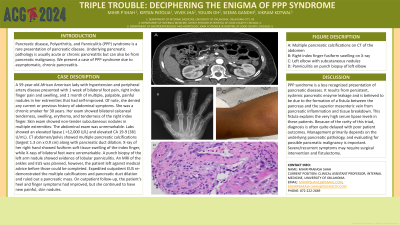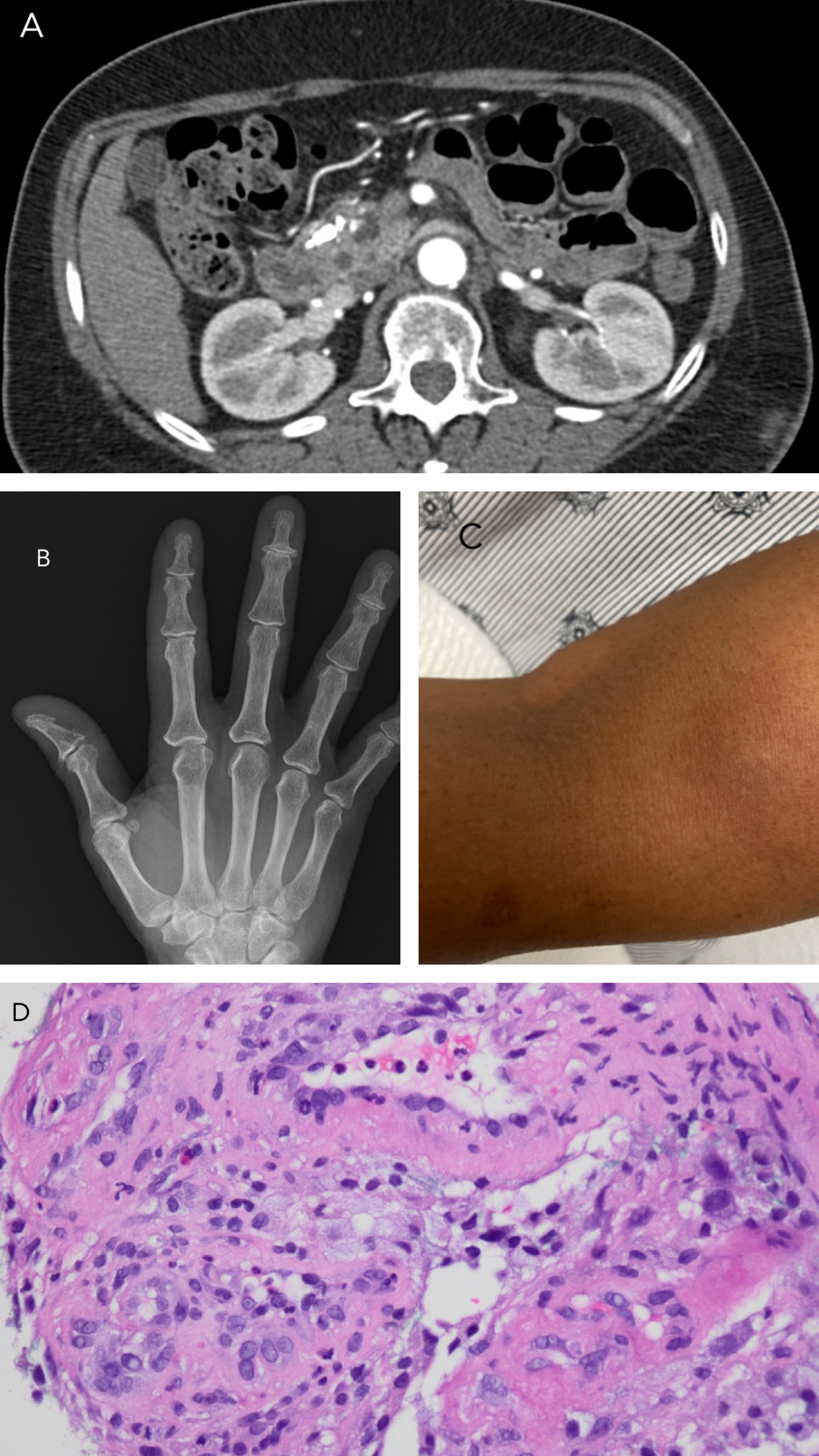Monday Poster Session
Category: Biliary/Pancreas
P1869 - Triple Trouble: Deciphering the Enigma of PPP syndrome
Monday, October 28, 2024
10:30 AM - 4:00 PM ET
Location: Exhibit Hall E

Has Audio

Mihir Prakash Shah, MD
John H. Stroger, Jr. Hospital of Cook County
Oklahoma City, OK
Presenting Author(s)
Mihir P. Shah, MD1, Kirtan Patolia, MD2, Vivek Jha, MD2, Youjin Oh, MD2, Seema Gandhi, MD2, Vikram Kotwal, MD2
1John H. Stroger, Jr. Hospital of Cook County, Cook County, IL; 2John H. Stroger, Jr. Hospital of Cook County, Chicago, IL
Introduction: Pancreatic disease, Polyarthritis, and Panniculitis (PPP) syndrome is a rare presentation of pancreatic disease. Underlying pancreatic pathology is usually acute or chronic pancreatitis but can also be from pancreatic malignancy. We present a case of PPP syndrome due to asymptomatic, chronic pancreatitis.
Case Description/Methods: A 59-year-old African American lady with hypertension and peripheral artery disease presented with 1 week of bilateral foot pain, right index finger pain and swelling, and 1 month of multiple, palpable, painful nodules in her extremities that had self-improved. Of note, she denied any current or previous history of abdominal symptoms. She was a chronic smoker for 30 years. Her exam showed bilateral calcaneal tenderness, swelling, erythema, and tenderness of the right index finger. Skin exam showed non-tender subcutaneous nodules in multiple extremities. The abdominal exam was unremarkable. Labs showed an elevated lipase ( >12,000 U/L) and elevated CA 19-9 (381 U/mL). CT abdomen/pelvis showed multiple pancreatic calcifications (largest 1.3 cm x 0.9 cm) along with pancreatic duct dilation. X-ray of her right hand showed fusiform soft tissue swelling of the index finger, while X-rays of bilateral feet were unremarkable. A punch biopsy of the left arm nodule showed evidence of lobular panniculitis. An MRI of the ankles and EUS was planned, however, the patient left against medical advice before those could be completed. Expedited outpatient EUS re-demonstrated the multiple calcifications and pancreatic duct dilation and ruled out a pancreatic mass. On outpatient follow-up, the patient’s heel and finger symptoms had improved, but she continued to have new painful, skin nodules.
Discussion: PPP syndrome is a less recognized presentation of pancreatic diseases. It results from persistent, systemic pancreatic enzyme leakage and is believed to be due to the formation of a fistula between the pancreas and the superior mesenteric vein from pancreatic inflammation and tissue breakdown. This fistula explains the very high serum lipase levels in these patients. Because of the rarity of this triad, diagnosis is often quite delayed with poor patient outcomes. Management primarily depends on the underlying pancreatic pathology, and evaluating for possible pancreatic malignancy is important. Severe/recurrent symptoms may require surgical intervention and fistulectomy.

Disclosures:
Mihir P. Shah, MD1, Kirtan Patolia, MD2, Vivek Jha, MD2, Youjin Oh, MD2, Seema Gandhi, MD2, Vikram Kotwal, MD2. P1869 - Triple Trouble: Deciphering the Enigma of PPP syndrome, ACG 2024 Annual Scientific Meeting Abstracts. Philadelphia, PA: American College of Gastroenterology.
1John H. Stroger, Jr. Hospital of Cook County, Cook County, IL; 2John H. Stroger, Jr. Hospital of Cook County, Chicago, IL
Introduction: Pancreatic disease, Polyarthritis, and Panniculitis (PPP) syndrome is a rare presentation of pancreatic disease. Underlying pancreatic pathology is usually acute or chronic pancreatitis but can also be from pancreatic malignancy. We present a case of PPP syndrome due to asymptomatic, chronic pancreatitis.
Case Description/Methods: A 59-year-old African American lady with hypertension and peripheral artery disease presented with 1 week of bilateral foot pain, right index finger pain and swelling, and 1 month of multiple, palpable, painful nodules in her extremities that had self-improved. Of note, she denied any current or previous history of abdominal symptoms. She was a chronic smoker for 30 years. Her exam showed bilateral calcaneal tenderness, swelling, erythema, and tenderness of the right index finger. Skin exam showed non-tender subcutaneous nodules in multiple extremities. The abdominal exam was unremarkable. Labs showed an elevated lipase ( >12,000 U/L) and elevated CA 19-9 (381 U/mL). CT abdomen/pelvis showed multiple pancreatic calcifications (largest 1.3 cm x 0.9 cm) along with pancreatic duct dilation. X-ray of her right hand showed fusiform soft tissue swelling of the index finger, while X-rays of bilateral feet were unremarkable. A punch biopsy of the left arm nodule showed evidence of lobular panniculitis. An MRI of the ankles and EUS was planned, however, the patient left against medical advice before those could be completed. Expedited outpatient EUS re-demonstrated the multiple calcifications and pancreatic duct dilation and ruled out a pancreatic mass. On outpatient follow-up, the patient’s heel and finger symptoms had improved, but she continued to have new painful, skin nodules.
Discussion: PPP syndrome is a less recognized presentation of pancreatic diseases. It results from persistent, systemic pancreatic enzyme leakage and is believed to be due to the formation of a fistula between the pancreas and the superior mesenteric vein from pancreatic inflammation and tissue breakdown. This fistula explains the very high serum lipase levels in these patients. Because of the rarity of this triad, diagnosis is often quite delayed with poor patient outcomes. Management primarily depends on the underlying pancreatic pathology, and evaluating for possible pancreatic malignancy is important. Severe/recurrent symptoms may require surgical intervention and fistulectomy.

Figure: A- multiple pancreatic calcifications
B- Right index finger fusiform swelling on X-ray
C- Left elbow with subcutaneous nodules
D- Panniculitis on punch biopsy of left elbow nodule
B- Right index finger fusiform swelling on X-ray
C- Left elbow with subcutaneous nodules
D- Panniculitis on punch biopsy of left elbow nodule
Disclosures:
Mihir Shah indicated no relevant financial relationships.
Kirtan Patolia indicated no relevant financial relationships.
Vivek Jha indicated no relevant financial relationships.
Youjin Oh indicated no relevant financial relationships.
Seema Gandhi indicated no relevant financial relationships.
Vikram Kotwal indicated no relevant financial relationships.
Mihir P. Shah, MD1, Kirtan Patolia, MD2, Vivek Jha, MD2, Youjin Oh, MD2, Seema Gandhi, MD2, Vikram Kotwal, MD2. P1869 - Triple Trouble: Deciphering the Enigma of PPP syndrome, ACG 2024 Annual Scientific Meeting Abstracts. Philadelphia, PA: American College of Gastroenterology.
